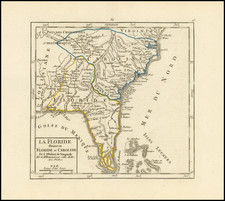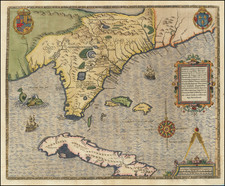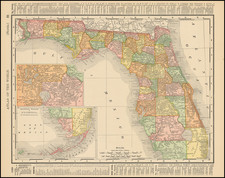From The American Revolution
Rare French edition of Sayer & Bennett's rare chart of Amelia Harbor, surveyed in 1775 by Jacob Blamey.
The map was produced as part of a set of sea charts and harbor plans designed for use by the French Navy, during the American Revolution.
Amelia Island is located on the boundary between Florida and Georgia. It has a strategic location and is the only territory in the United States to have been under eight different flags during its intriguing history. The anchorages within the deep-water harbor were used for all kinds of sailing vessels including smugglers, pirates, and slave ships. During the American Revolution, the island became home for English Loyalists fleeing the colonies.
This map charts the waterways surrounding portions of Amelia Island, Cumberland Island, Martin's ( Marteirs) Island and small Tiger's Island, showing anchorages, soundings and hazards. The ruins of Fort William are noted at the tip of Cumberland Island. This fort was built by the British Gen. James Oglethorpe, founder of the colony of Georgia, who successfully repelled Spanish troops from Georgia in 1742. A number of other landmarks and buildings are named, including the plantation of the Countess Dowager of Egmont on Amelia Island, with the reference key below noting the Cabane de Negres, et Fabrique d'Indigo of the plantation.
The chart was included in Le Rouge's rare North American Pilot, an atlas of Sea Charts compiled by the French Government and utilized by the French Navy during their participation in aid of the Americans during the American Revolutionary War. A fine wide margined example of this scarce French Naval Chart.
George-Louis Le Rouge (1712-1790), though known for his work in Paris, was originally born Georg Ludwig of Hanover, Germany. He grew up and was educated in Hanover, after which he became a surveyor and military engineer. Around 1740, however, Le Rouge moved to Paris and set up shop as an engraver and publisher on the Rue des Grands Augustins. It was at this time that he changed his name, adopting a French pseudonym that would later become quite famous.
Le Rouge spent much of his forty-year career translating various works from English to French, and his cartographic influence often came from English maps. His experience as a surveyor and engineer in Germany made him a skilled and prolific cartographer, and he produced thousands of charts, maps, atlases, and plans. His work spans from garden views and small-town plans to huge, multiple-continent maps. Le Rouge eventually accepted the position of Geographical Engineer for Louid XV, the King of France.
Later in life, Le Rouge became well-known for publishing North American maps, such as in his Atlas ameriquain septentrional of 1778. One of Le Rouge’s other more famous works is the Franklin/Folger chart of the Gulf Stream, which he worked on with Benjamin Franklin. Franklin and Le Rouge corresponded around 1780 and collaborated to create this map, a French version of Franklin’s famous chart which was originally printed in 1769.













![(American Revolution) Geschichte der Revolution von Nord-America. Sammlung der besten Schriftsteller, welche die Geschichte, besondere Rechten, Sitten, und Gewohnheiten der Völker nach ihren Grundsätzen abgehandelt haben [with map:] Die Vereinigten Staaten von Nord=America. nach der Wm. Faden 1783. [History of the Revolution of North America. Collection of the Best Writers Who Have Discussed the History, Specific Laws, Customs, and Habits of the Peoples According to Their Principles [with map:] The United States of North America. According to Wm. Faden, 1783.]](https://storage.googleapis.com/raremaps/img/small/90124.jpg)
